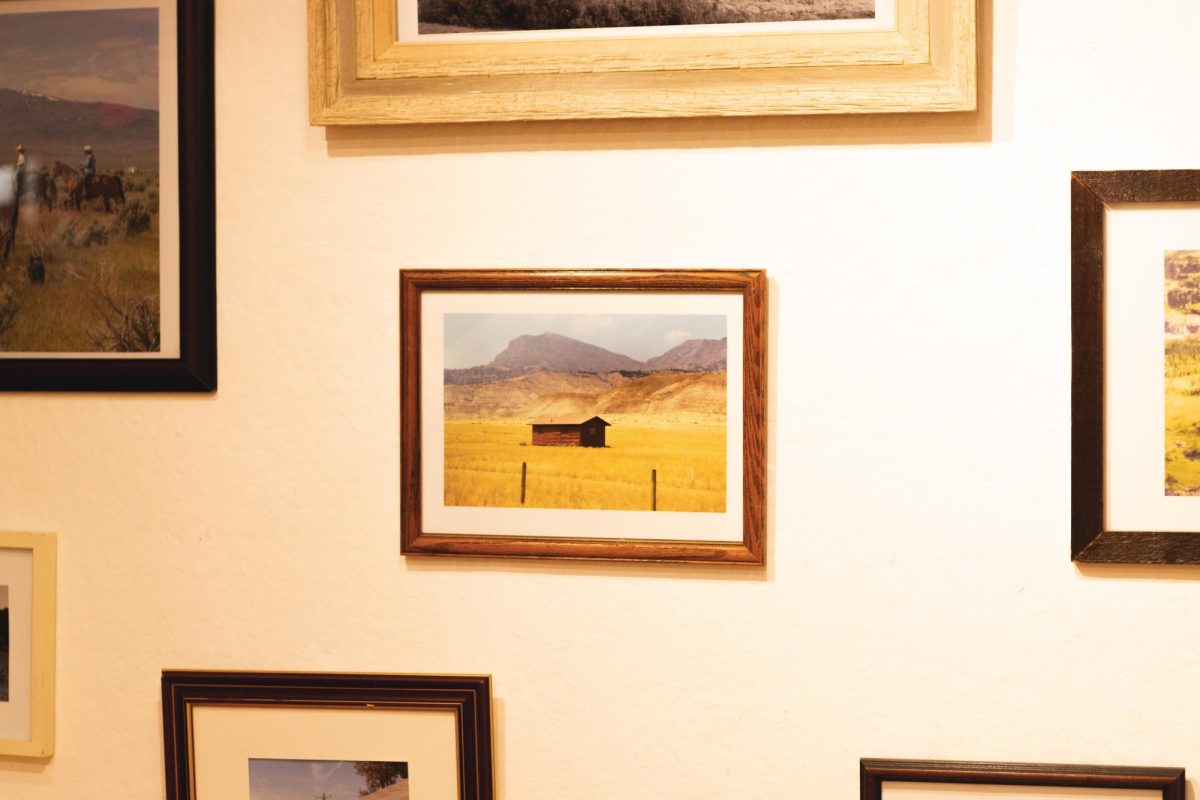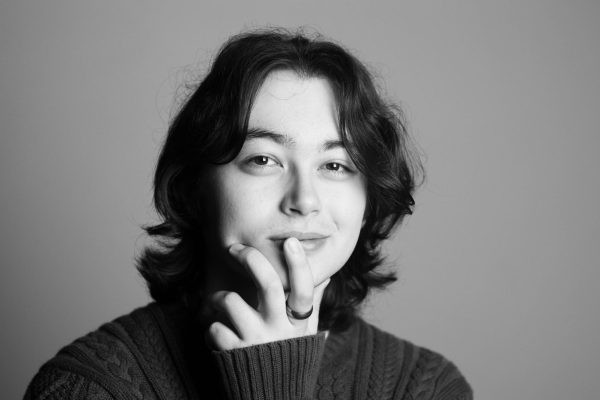On March 6, the final theses of Fordham Lincoln Center seniors Brenda Bouvier and Alison Kulak debuted in the Ildiko Butler Gallery. While the gallery, situated at the bottom of the Lowenstein Center escalators, houses the work of various artists throughout the year, the spring semester exhibitions are particularly special: during this time, senior visual art majors have the unique opportunity to display their final thesis for approximately two weeks.
Both thematic elements and medium are taken into account when determining pairings for the gallery exhibition, and although students can request partners, the decision ultimately falls to the visual arts faculty. Fortunately enough, the request of Bouvier, Fordham College at Lincoln Center (FCLC) ’25, and Kulak, FCLC ’25, was approved, and “Roots” was born.
As soon as you step inside the space, the rationale behind this pairing becomes apparent. While Bovier and Kulak’s theses vary in subject matter and medium, both evoke a serendipitous charm, and the thematic and visual cohesion between the two artists’ installations is undeniable. The pair are best friends and roommates, a relationship that creates a palpable sense of unity within the exhibition. But their work still manages to maintain its distinction. It is this variety that makes “Roots” so multi-faceted.
Her thesis explores the passage of time, invoking nostalgia as a means of returning viewers to childhood whimsy.
Comprising poetry, textile work, music and video elements, Bouvier’s multi-media installation is a collage in and of itself. Her thesis explores the passage of time, invoking nostalgia as a means of returning viewers to childhood whimsy. While this project is a continuation of Bouvier’s interest in collages, this thesis marks a major increase in complexity within her work. Bouvier’s application of collage has evolved from smaller paper pieces into a larger-scale project that incorporates textile elements, and this development stems from a newfound courage motivating her artistic process.
While “Roots” is a multi-media spectacle, this is something Bouvier had to work her way up to, and in doing so, she had to surpass a fear of discord within the project. She said that despite fearing a lack of unity, she has grown a lot in terms of incorporating a range of components within her work; this evolution is apparent, especially when analyzing the variety that defines her installation.
“I realized that since artwork is a reflection of yourself, there’s not really any limits to what you do,” Bouvier said.
While her use of media is diverse, these distinct components come together to tell a story of retention and evolution.
While Bouvier’s thesis contains various components, the quilt, which consists of an amalgamation of family photos, found fabrics, magazines and even pieces that Bouvier embroidered herself, is arguably the centerpiece of her project. The quilt also features what she described as an “abstract family tree.” The quilt is undoubtedly a labor of love, as the majority of these details are hand-sewn in what she admitted to being a painstaking process.
Bouvier revealed that she had originally gotten the idea for the textile element from a ride on the Ram Van. After seeing blocks of graffiti that resembled a quilt, she said that she realized the thematic relevance one could have in her thesis. Heritage and the collection of memory are two huge focuses of her project. Therefore, a quilt, which is a physical manifestation of the compilation and preservation of experience, became the perfect means of demonstrating these ideas.
Bouvier’s family is another major source of inspiration for her work. Her mother was born and raised in the Netherlands, and a significant portion of her family lives in Friesland, a province in the northern part of the nation. Bouvier also spent last summer working on a farm in the Netherlands, an experience that she said brought her closer to her family and the land they are grounded in. Her Dutch heritage shines through in several aspects of her project, but it is especially prevalent in the fairy house and music box that sits on top of the pedestal in the right corner of the exhibition.
Beyond the textile element, music plays a major role in Bouvier’s portion of “Roots,” and the song that plays alongside the video component of her project is a piece titled “Follow their way” that Bouvier composed herself. While her use of media is diverse, these distinct components come together to tell a story of retention and evolution. In “Roots,” Bouvier manages to capture the process of growing up, while simultaneously celebrating “this magical, ethereal view of the world and nature” that we have as children. It is this exploration of our connections to nature that elevates the unity between Bouvier and Kulak’s projects beyond the aesthetic level.
The other half of “Roots” displayed on the left side of the gallery consists of Kulak’s work, who manufactured a beautifully homey exhibition documenting a striking journey out west. During a ten-day road trip, Kulak visited Idaho, Washington, Montana and Wyoming alongside her partner, who was the main source of inspiration for this project. Born and raised in Pennsylvania, Kulak had never been exposed to the beautiful expanses of the West, but after visiting her partner’s home in Idaho for the first time, she was struck by the landscape, its inhabitants and their relationship with the land.
With a variety of vintage frames sourced from thrift stores adorning the wall, Kulak’s contribution to “Roots” is simultaneously foreign and familiar, and the frames house gorgeous prints documenting Kulak’s trip. These digital photos capture life out West from a distinctly metropolitan East Coast perspective, providing city-dwellers with a rare glance into the more rural parts of the U.S.
Not only do her photos manage to capture the vastness of the West, but they also compassionately document both the human and animal life that exists within such land, and the considerable research she has invested into this project shines through in her work.
As a visual art major with a minor in environmental studies, Kulak’s final thesis is the perfect fusion of her interests. Her journey was funded by the FCLC Dean’s Undergraduate Research and Creative Practice Grant. The grant application process involved weeks of research, after which Kulak formulated a proposal, budget and an eight-week schedule under the tutelage of her faculty mentor, Stephan Apicella-Hitchcock.
Kulak was shocked and disappointed by the contrast between the practices of small-scale farming families like that of her partner and corporate unethical farming businesses. This disparity is ultimately what motivated Kulak’s thesis, and through her research and photography, she investigated what it means to form a more meaningful and ethical relationship with the environment.
Her research culminated in a photo book consisting of a stunning compilation of her photography throughout her travels. The book rests on a corner table alongside embroidery and various household items, all of which contribute to the snug and inviting feel of the exhibition.
Kulak’s curiosity and wonder manifest brilliantly in her photography, and while she captures scenes that may be unfamiliar to many of us, she does so through a well-informed lens. Not only do her photos manage to capture the vastness of the West, but they also compassionately document both the human and animal life that exists within such land, and the considerable research she has invested into this project shines through in her work.
While the photographs are the focal point in Kulak’s installation, she has also manufactured a faux home, complete with a rustic coat hanger from which one of her sweaters hangs. Before “Roots” was on display, Kulak could often be seen around campus wearing this very garment, and her choice to include it contributes to the intimacy of the exhibition.
With its diverse range of mediums and overlapping themes, “Roots” is a beautiful set of installations that inadvertently demonstrates the capacity for friendship to unite artists and their work. “Roots” was on display until March 24, but during its brief life, it authentically displayed the culmination of Bouvier and Kulak’s efforts as well as the variety of expression that Fordham’s art students have to offer.
The end of “Roots” marks the beginning of a new exhibition, and the work of Madeleine Johnson, FCLC ’25, and Claire Seka, FCLC ’25, which opened on March 25 and will be on display until April 8.


